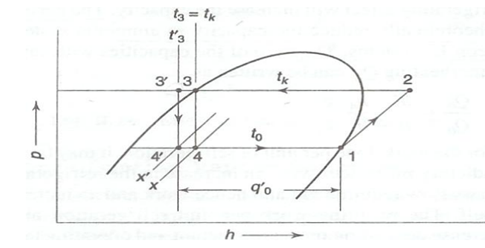Effect of Liquid Sub cooling:
This is possible to diminish the temperature of the liquid refrigerant to in a few degrees of the temperature of the water inflowing the condenser. In some of condenser designs it is attained by installing a sub-cooler among the condenser & the expansion valve.
The influence of sub-cooling of the liquid from t3 = tk to t3' is indicated in given fig. It shall be seen that sub-cooling diminished flashing of the liquid throughout expansion and increases the refrigerating effect. As a result, the piston displacement & horsepower per ton are diminished for all of refrigerants. The percent increase is less pronounced in the case of ammonia due to its larger latent heat of vaporization as compared to liquid specific heat.

Effect of Liquid Sub cooling
Cooling water normally first passes by the sub cooler and then by the condenser. Therefore, the coolest water comes in contact through the liquid being sub cooled. But this is results in a warmer water inflowing the condenser and therefore a higher condensing temperature & pressure. Therefore, the advantage of sub cooling is offset by the enhanced work of compression.
It can be ignored through installing parallel cooling water inlets to the sub cooler & condenser. However, in this case, the degree of sub cooling shall be small & the added cost of the sub cooler & pump work cannot be valuable. It can be more wanted to use the cooling water efficiently in the condenser itself to remain the condensing temperature as close to the temperature of the cooling water inlet as achievable.